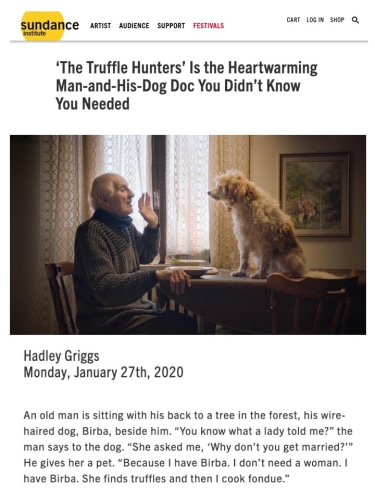‘The Truffle Hunters’ Is the Heartwarming Man-and-His-Dog Doc You Didn’t Know You Needed
Sundance Institute
01/27/2020
Back
by Hadley Griggs
An old man is sitting with his back to a tree in the forest, his wire-haired dog, Birba, beside him. “You know what a lady told me?” the man says to the dog. “She asked me, ‘Why don’t you get married?’” He gives her a pet. “Because I have Birba. I don’t need a woman. I have Birba. She finds truffles and then I cook fondue.”
Welcome to the delightful world of The Truffle Hunters, which directors Michael Dweck and Gregory Kershaw stumbled upon quite by accident. While on a trip in a tiny town in Italy, Dweck said that a townsperson said something strange to him: “‘I put 50 euros outside in a box at night, and in the morning, a truffle appears. And I have no idea how it gets there.’”
Dweck’s interest was piqued. “All they knew were there were these men in the woods, and they’d never met them before, they just know they exist and don’t ever want to be found”—and those men are truffle hunters.
“It took us a year to really get into the community,” Dweck said. “We had to drink a lot of wine and a lot of espresso. That’s always how our meetings started in their homes.” Eventually, though, they became friends. “We’d go out truffle hunting with them, they’re 88 years old—and we’d be chasing them.”
Three years later, and they have a film that paints an overwhelmingly immersive picture of life as an Italian truffle hunter—from the woods to the cobblestone streets to the old Italian music. “It was so important to us to capture the feeling of this place,” Kershaw said. “When we were traveling around these villages, we felt like we were going through Italy in the 1960s. Everything in the filmmaking is about bringing the audience into this feeling of another place, another time. We tried to find songs that were evocative of this. Ed Cortez, the composer, he helped us find old Italian pop tunes and beautiful opera to fill out this world.”
But they didn’t stop there. To make the documentary even more immersive, they did a little engineering. “We knew we had to capture the dogs’ perspective in a really unique way,” explained Kershaw. “We found this shoe cobbler who helped us build these head mounts, and we put a little camera on the dog’s head.” Then they sent the dogs out into the woods as if it were a regular truffle hunt.
When they got the footage back, they couldn’t believe it. “It was like, ‘Oh my god, you are the dog.” And they’re right—those scenes are a frenetic romp through the leaves and moss and trees of Italy. I felt like the dog: sniffing the trees, shaking water off my back, digging in the dirt.
The mounted cameras also helped the filmmakers get pure, unfiltered footage of the truffle hunters themselves. “When we put the cameras on the dogs and sent them away, we discovered that they have their own language that they speak with the dogs—it’s not Italian, it’s not dialect, it’s this whole other language that they’ve invented.”
After the premiere, the filmmakers started the Q&A off with a special surprise—a live video call on the theater screen with one of the truffle hunters, Sergio. But rather than sitting in an office space or at his home, Sergio was standing out in the dark woods of Italy, his dog Fiona pulling at her leash. “He’s going to look for some black truffles right now,” his translator explained. Sergio pulled something out of his pocket to show us—a bag of truffles he’d already found.